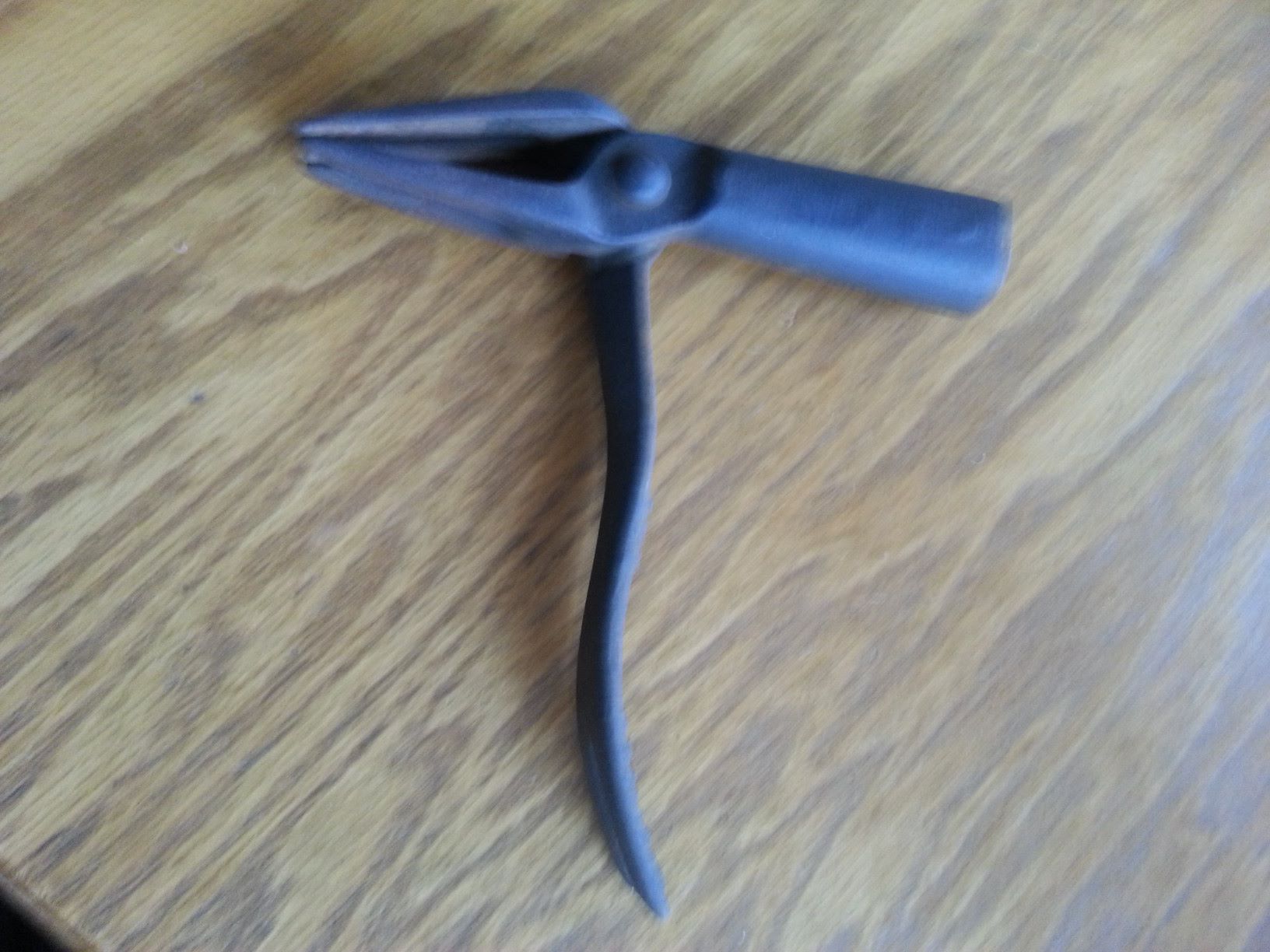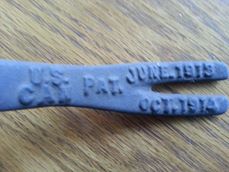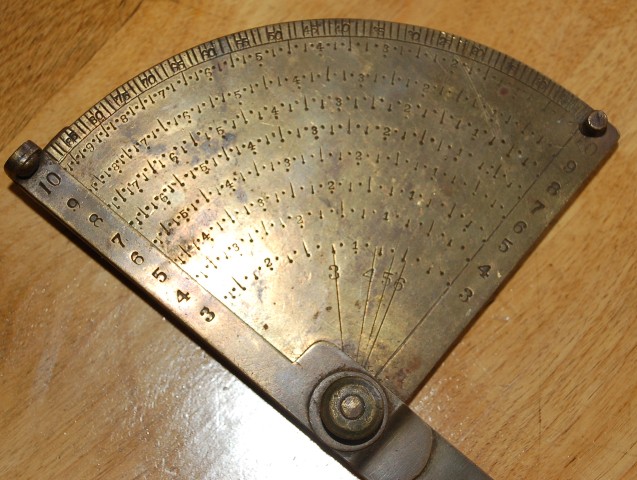Last updated: August 15, 2023
The last date someone sent a quiry.
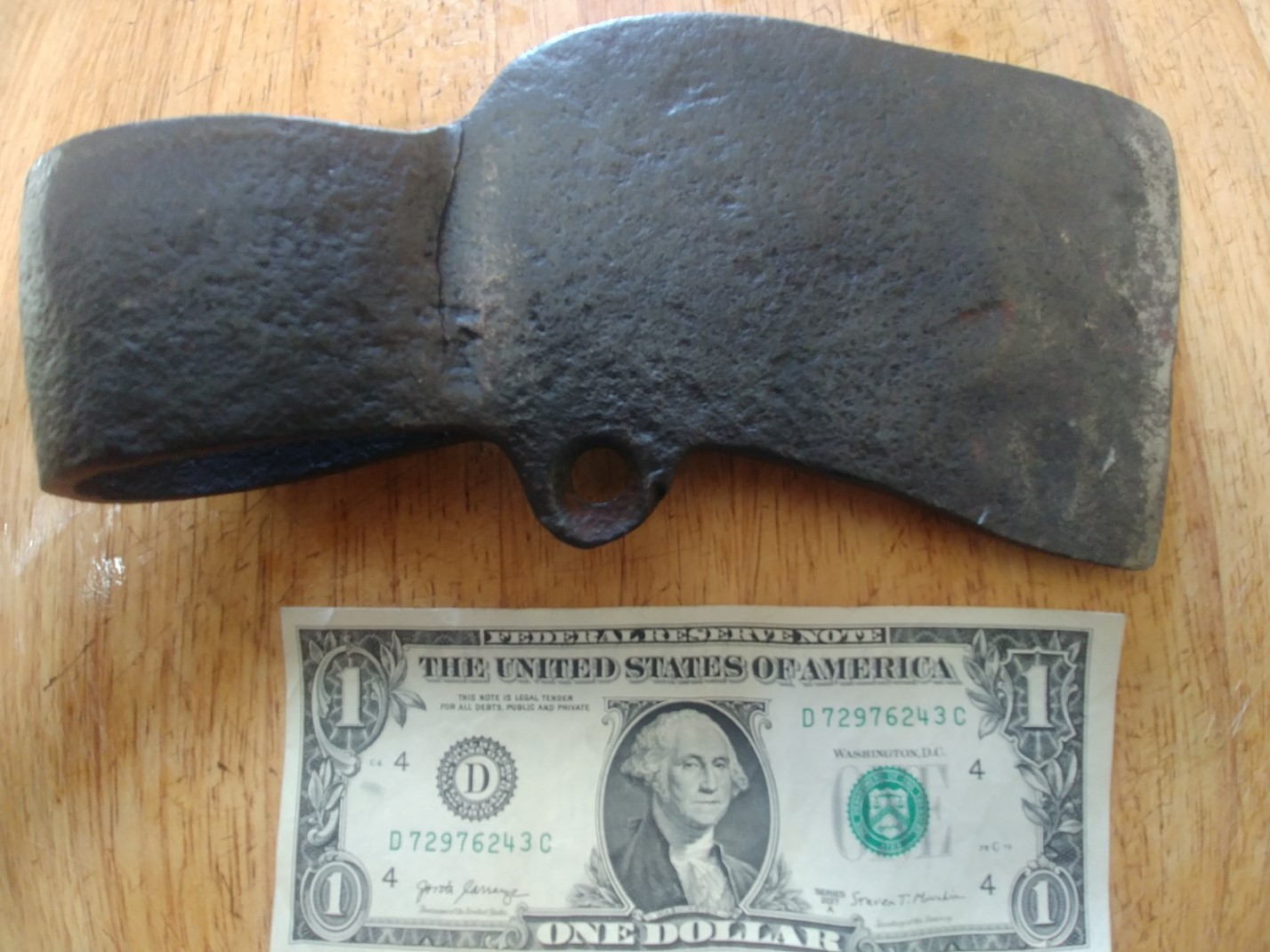
Very early handwrought axe, but what's the ring for? Axe seems too large to hang from a belt; possibly from a hook or branch. Any thoughts?
Paul B.
This was found in the woods by a hunter.
Does
it belong on a machine of some sort?
2.
.jpg)
.jpg)
Old spud tool. It has a bronze shaft and a brass pommel with
a fancy hex nut.
Measures 44 inches long - too short to be ??? pcrolffs
1.
Kristy P. sent this one in. Any
ideas?
Could it be a gardening tool?
These (below) have been identified.
*************************************************
Looks like it opens and loose straw (or Asparagus} would be clamped
in it and then trimmed.
For cutting broom straw. Thank you, J. F. 5.9.20
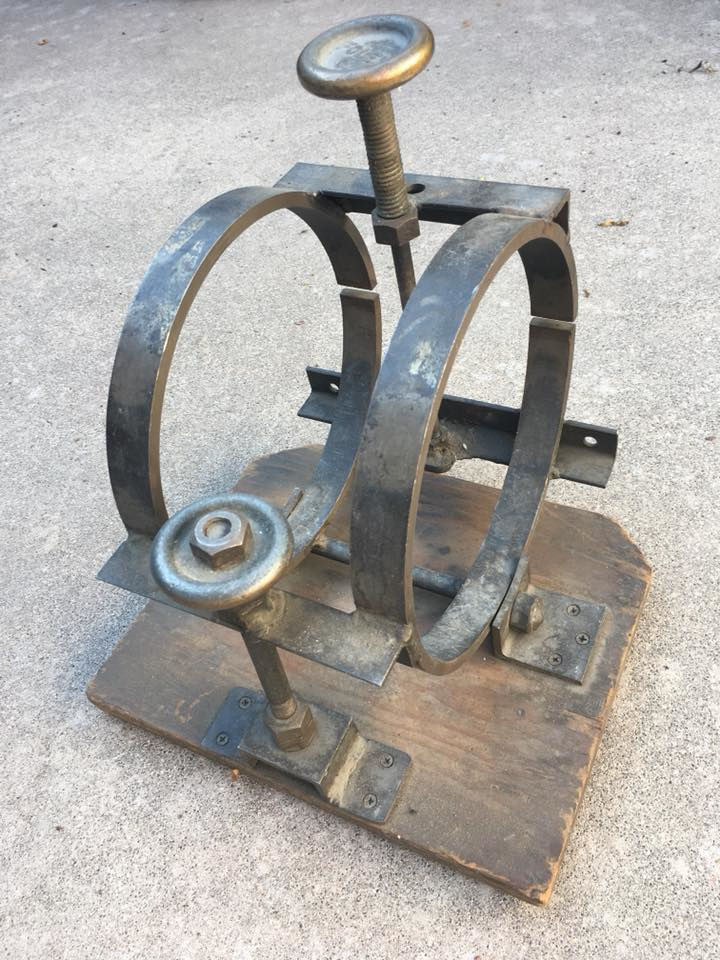
Do you know what this is? Was posted by a friend of mine
and no one seems to know.
I had fun guessing at the ones on your site.
My friend thought it may be some kind of a pipe holding device.
Should be around 12 inches tall. Thanks for taking a look. A. W. 7.7.18
***************************************************************************
Two responses in the same day.
Thank you both.
Blacksmith plier to hold a pipe
Roger J 4.11.20
It looks to me like it was made for prying
fencing or barbed wire that had been nailed/stapled to a post.
Ralph 4.11.20
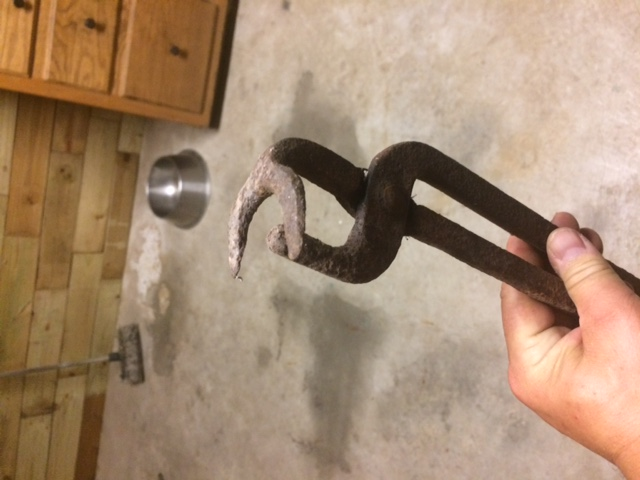
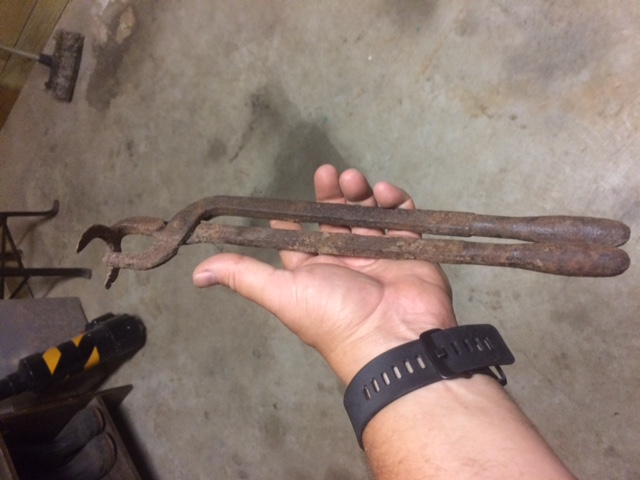
Wondering if someone could help me identify this old tool.
It came from my grandfathers place in North Louisiana.
He used to do some blacksmithing work so it may be related to that field. D.S.
7.27.18
********************************************************************
Not quite like a modern one but, the hammerhead
tool may be a tool
for replacing strike hammer heads in a piano.
S.R. 1.23.20 Thanks,
Susan
. 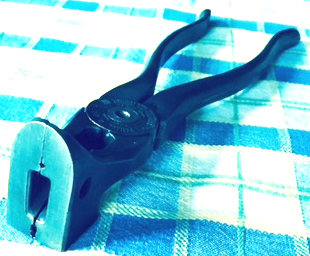
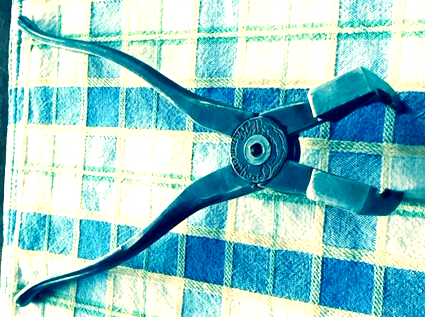
Any idea as to what this tool is and what
it does?
It is marked HAMMERHEAD with a pic of the shark by that name on one side.
The other side says : Catalog # H-1, Efficiency Tool Company Inc., Made in
USA .
Thanks. Dennis J. 10.23.2016
********************************************************
Seems to me it's a fish scaler.
The hooked knife is used for gutting the fish, and the teeth are used for
scaling.
It's been many many years but I seem to remember my grandfather having one
exactly like it.
Dave B. 12/17/2017 (That's a possibility. Thanks Dave)
My thought is that this may not be a woodworking tool.
I thought about it
being a seed remover for fruits with a large seed, such as a mango.
The only markings on the blade is "Stainless Steel Norse" and the
entire tool is just over 8" long.
The handle is a very fine-grained wood painted black, which at first I thought
was bakelite.
The oval metal part is serrated and the middle blade could have been sharp
but isn't now.
I don't think it is ancient but figure it has got to be fifty to seventy years
old.
Thanks so much for any help
you and your fans can give me.
Judy
M. 3/13/2017
***************************************************************************
Just looking over your what is it pictures
and believe the second one
is for setting rivets on brake shoes
liners for old drum type brakes.
I have a much larger one that
was made for commercial trucks.
R.G. NY 5/01/2017 Thanks, Bob.
The number five press may be a watch makers tool that takes
different size inserts. Just an idea, thanks.
S.R. 1/23/20 Thanks,
Susan
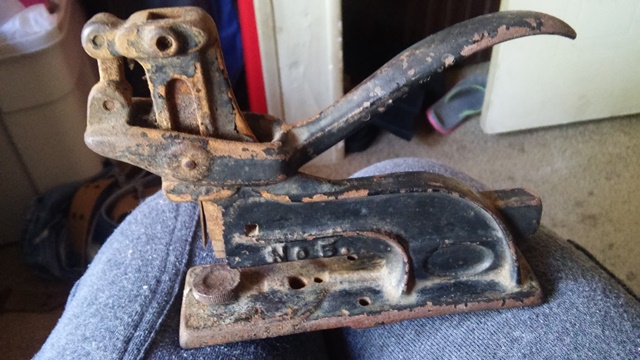
The press looking tool has "No. 5" pressed on one side of it.
Would appreciate any help I can get. Thanks.
Sissy James 2.12.2017
**************************************************************************
Louis Neff had patents for tools used to shape the collars
that men wore
back at the turn of the century.
Probably used at a laundry facility while cleaning.
He has patents for these
tools.
Another one that I've seen looks more like a pair of pliers,
but he probably
had different tools shaped for various purposes.
This is my guess anyway. R.R., NJ 3/18/2017
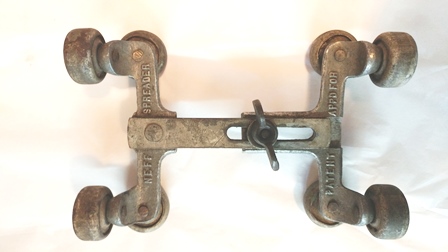
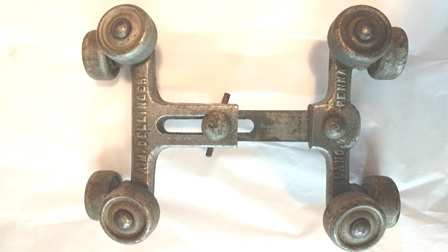
This item was brought into my retail shop the other day by a customer.
Marked NEFF SPREADER and A.M.DELLINGER, LANO, PENNA
Any thoughts? 2.16.2017
***********************************************************************************
The round cast iron item with three set screws is a horn
weight.
It was put on the end of a bull's horns to make them curl down.
They were sold in pairs so you would weight both horns.
We used them on Hereford
bulls which had rather straight horns.
With a curled horn there was less chance for injury when the bulls
would get
in fights with one another.
You would remove them when the horn was curled down as far as needed
so the
sharp end of the horn would not gore an opponent.
The other item is a dehorning iron. You would use it much
like a branding iron.
The end of it should be concaved to fit on an emerging horn of a young calf.
You would heat the iron over a fire until red hot and then apply it to horn.
By burning the emerging horn you would kill it and it would not grow.
It was kind of brutal but was a good way to make sure that your cattle
did
not have horns when they matured.
Again, we used it on Hereford calves.
Some breeds like Angus do not have horns so it was not used on them.
Some ranchers would use a specialized dehorning clipper to cut the young horn
but sometimes the horn would not completely die and would grow stunted and
deformed,
often curling into the animal's skull.
Burning the horn was much more effective. (Tom
B. 12/23/2016)
We have asked a multitude of people, from older farmers and
handymen
to people who are fairly knowledgeable about this "tool",
to no avail...
there are about six of these in two different circumference's at the tapered
end.
The round "ball" part is hollow which seems to fit over the tapered
end of the rod
and has three "set screws" to hold it on the tapered end or whatever
may fit between them...
the iron bar is approx 2' long...any help would be appreciated. Victor
S. 8/13/2016
The whale tailed looking cast iron piece (#3?) is half
of a tire bead breaking tool.
Needs a long handle with a J-hook on the end for holding onto the rim
while you place the 'tail' part on the tire need the rim
and press down on
the long leverage handle to 'bust' the tire off.
Have the exact same complete one at home - useful tool.
Cheers, Mark 8/13/2016 Thank you, Mark
It's a Ken-Tool. T-100. Here's my 'restored' one.

At first I thought it was a pie crimper, but its cast iron
and really heavy.
It probably is a pie crimper but would like to know from the professionals.
Whales tail tool is 10 inchs long and the tail is 5 inch's wide; it weighs
2lbs.
Thanks in advance. Neil
*********************************************************************************
Looks like an early version of a wire strainer used in tensioning wires
when erecting a fence.
It may be missing a piece or two.
Type wire strainers in Google, then select Images to see pictures of varying
types (old and current).
There are of course many versions.
The two hooks would work their way along an appropriate sized chain,
link
by link, to increase the tension on the wire
that the chain is attached to by means of some sort of clamping device.
Andrew G. 1-23-2016 Thanks Andrew
I found this tool and no one around here has any idea what it is.
Any ideas, or is there a place where I can go to get things identified?
Thanks...Leland 12/28/2015
Not 100% certain, but first thought is a wooden japanese pillow.
Refer to picture below. Andrew G. 1-23-2016 (No pic
yet.) Thanks Andrew
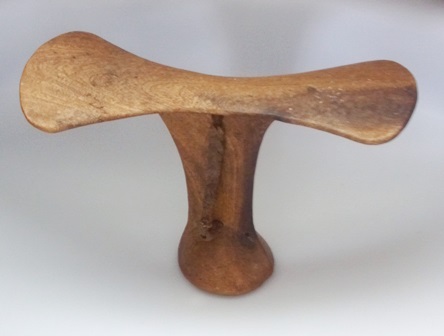
Wooden object found at recent antiques show in up-state New York.
Top approximately 12 inches long. Total about 6 inches high. March,
2014
**************************************************************************
Hi there!
I was just looking at your website
and I think that item #5 is a pair of ladder
jacks.
I could be wrong but they look a lot like the ladder jacks
that we found in
my grandfather's garage.
Lisa 11-17-2015 [Thanks, Lisa]
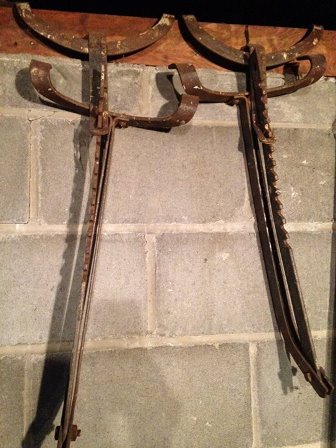
Trying to ID these for a friend.
They have no markings, he knows nothing about them,
and I could find nothing
online that looks similar…though admittedly,
I had no idea what to use as a keyword search…
Clamp? Spreader?
Thanks! Mike
*****************************************************************************
I believe that the tool at the top of
your page
labeled “pliers or crimpers” is a saw set.
The threaded hole (assuming it goes all the way through)
would be for the
screw to set the amount of set given to each tooth.
Thanks, Tom 11/02/2015
{Assistant Director of Facilities and Collections, Jeanes Discovery
Center Mayborn Museum Complex Baylor University}
Thank you, Tom, for that helpful insight.
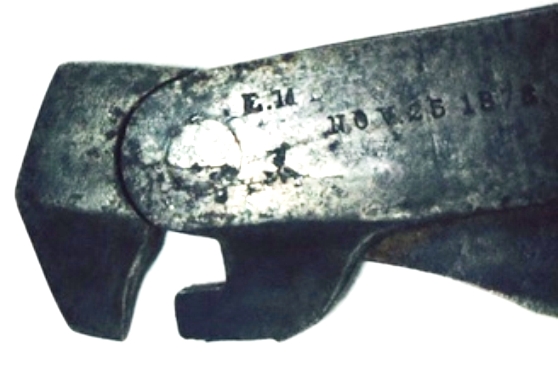
I have this pair of pliers or crimpers as I would call them
and haven't been
able to identify them.
They are 8" long and there is a threaded hole in the top of the stationary
jaw,
The date on them is Nov 25 1873 and has EML stamped on them
which I think
may be the original owners initials.
Any help would be greatly appreciated. James N. July, 2015
***********************************************************************************
I was Googling around for antique tools and came
across your page.
I was very excited to find your "What's It Page,"
and I can help
you identify Chris F's Stanley tool.
It's a Stanley Spoon, used in the autobody repair trade.
It's used for pushing out dents in tight spaces
and used in place of a dolly
iron or dolly bar for hammering and smoothing.
I had one many years ago, as my father had an autobody repair shop.
Marty G. 7-23-2015
Thanks, Marty
Can you tell me what this is for and is called?
It is made in the USA by Stanley but that is all I can figure out.
Tried to Google it with no luck. Chris F.
******************************************************************************
It is a grafting frow for grafting tasty stock onto solid rootstock
I have several like that one in my collection
I grew up on a 10 acre orchard
my father did a fair amount of grafting but he used a pocket knife
Scots ancestry - why buy another tool
Sam P. 4-14-2015 Thanks, Sam.
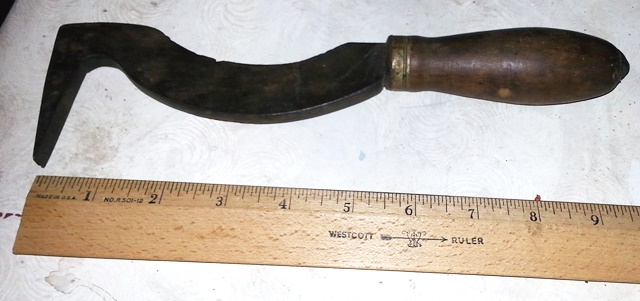
Do you have any idea what this tool is and what it was used
for?
Inside
of the curved edge is sharp. Vic M.
********************************************************************
This looks very much like a handmade beading loom.
Just like a hand weaving loom some form of line/string
was wrapped
around/between the teeth on either side
until the desired number of rows was
wound.
Then a separate line was strung with beads,
laid on top of the other lines,
and then threaded back through the beads to hold them in place.
Fairly complex patterns can be created.
Since almost all of these used to
be handmade
they come in all kinds of shapes, sizes, and design.
Dave 7-03-2015 Thanks,
Dave.
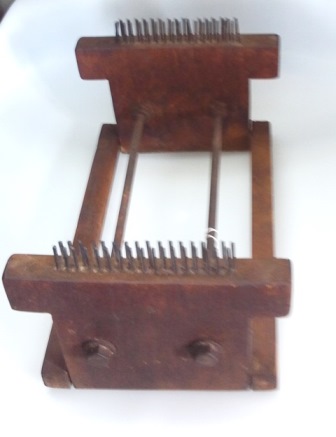
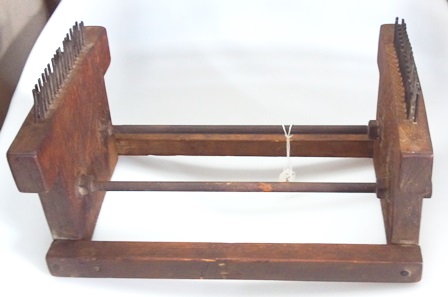
Could this have been a loom, or part of a loom?
About 14 inches long and 10 inches wide.
Also found at same antiques show. March, 2014
************************************************************************************
The hex wrench is for European style mine rails, they use screws to hold
the rails into the ties.
Bar inserted at top for leverage.

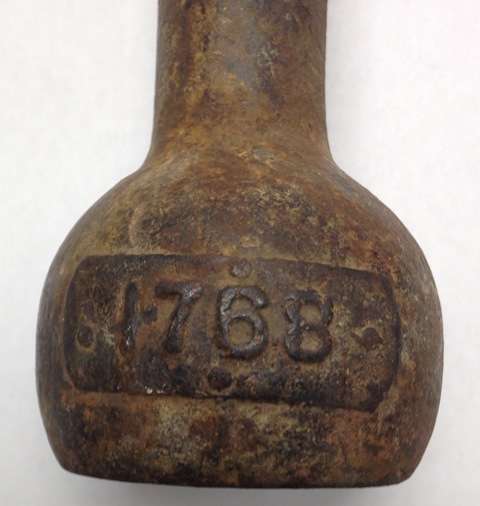
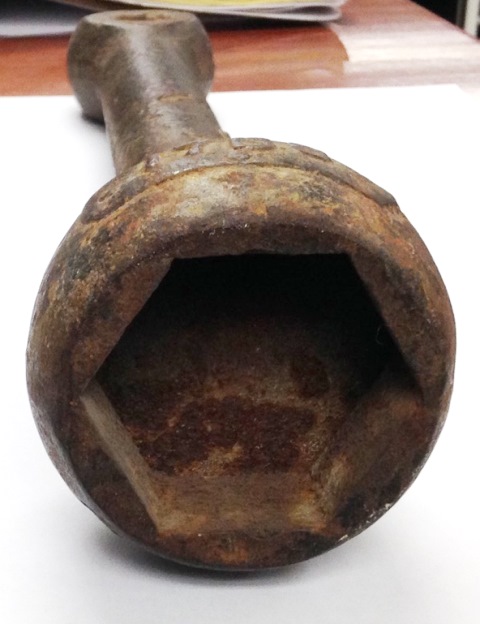
Hello I’m hoping you can help me identify what this
socket may have been used for
and if the tag is showing the date or the part number of the item.
I got it from the Kennecott Copper mine in Alaska(which closed in 1938)
Thanks. Dennis Hamann
************************************************************************************
The 2 handle device iron and wood with hole (30lb) is early form of post
pounder,
slides over a post and pounds it into earth. JZ (2/24/15) Thanks
again, John
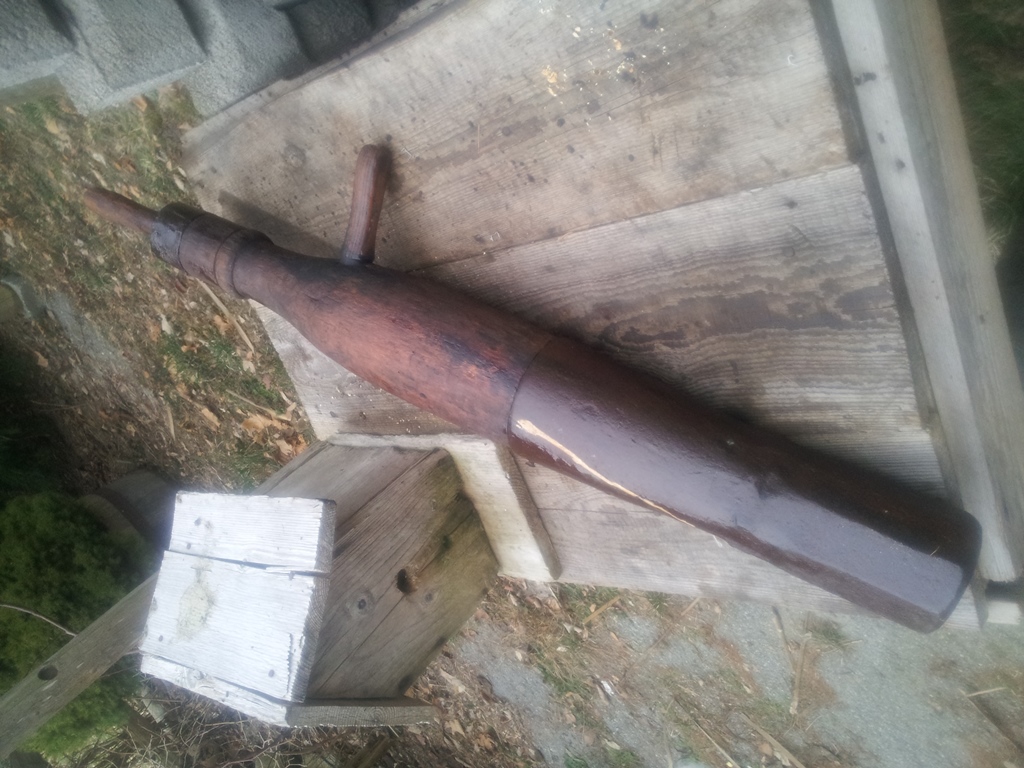
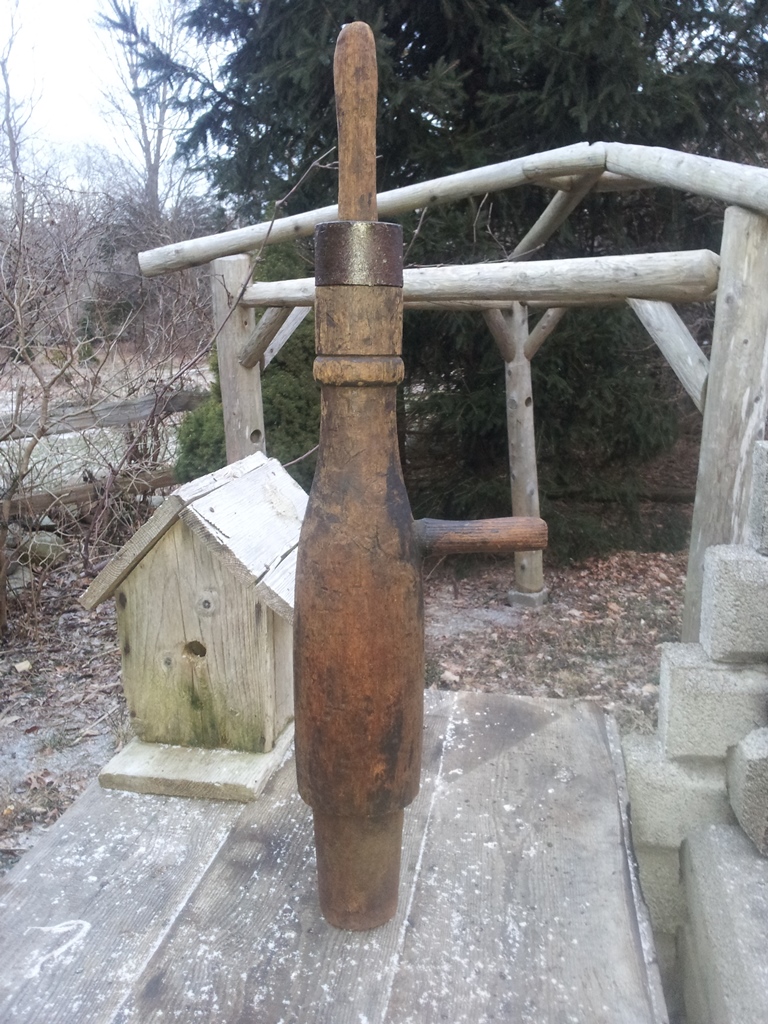
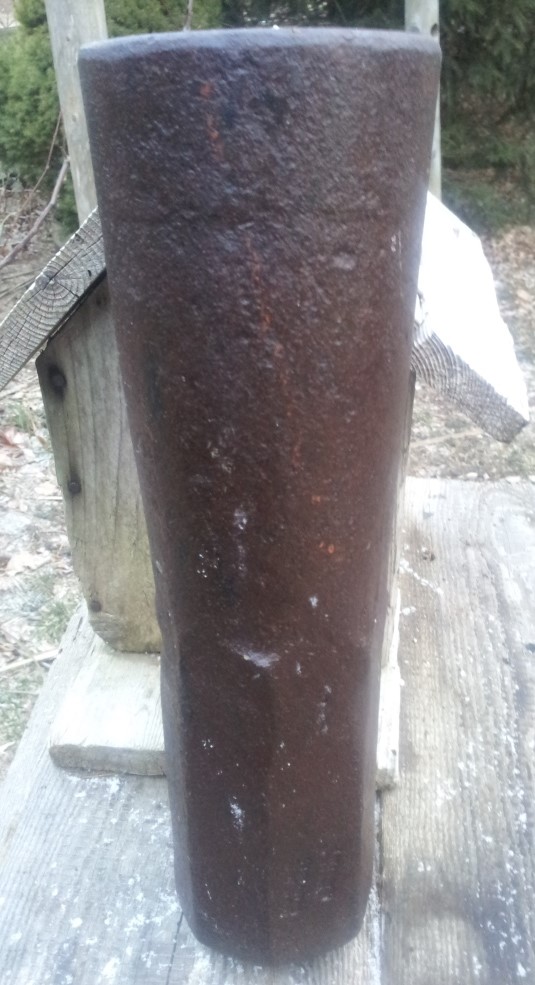

Hi. Have no idea what this is. The iron part is held together with only one
screw.
One top handle, on side handle. Iron part is half hollow. Entire iron weight
is over 30lbs. (MS)
*****************************************************************************
That last object is very identifiable to us here in Mississippi.
It is for shucking oysters, clams, mussels, or other shellfish.
We all laughed when we saw it....
Wow, I don't think they are made anymore
and the ones we have seen
are very worn and barely functional.
Doubtful if that one was used very much.
Certainly not used in a salt water
environment very long if at all.
Very nice, almost pristine condition.
THANKS AGAIN, MA 12/23/2014
************************
Kinda complex but it looks like it could be a nut splitter,
maybe walnut.
I doubt it, but it's a thought. W.P.
Help.....my father who has now passed away collected everything.
Tools was one of the collections.
He had blacksmith tools, farm tools and
woodworking tools.
This is one that I don't think he could identify as he had a label on it
that said..."iron gadget".
It is a mystery that I would love to
solve.
It measures approx. 8" long. No makers mark that I can see.
Can anyone
help me!? Thanks in advance...... Therese S., Buffalo NY
*********************************************************************************
Whatever the object in the picture is, it is not particularly
old.
Searching for "tape tensioner", I found the several patents that featured
an extension
from the tape measure housing that could be secured
by a nail through an opening.
The hole in the end of the object may satisfy that function,
but it is difficult
to tell from the photograph what the larger end does.
I guess my answer is that it is difficult to tell without
some sort of context
for its association with a tape measure.
If the distance between the back of the hole in the object (the far right side
in the photo)
and the larger section,
which looks like it would hold the lip on the end of a tape measure,
is an
exact whole number distance in inches or centimeters,
then this thing would just hold the tape and allow the user
to add x inches
or centimeters to the total.
It is so simple that it is not likely to have been patented,
but it is the kind of point of sale thing that may have been sold
at hardware
stores to people waiting in line. Mjd
Maybe an explanation of its use would help.
The end of the tape is attached to the part that requires measuring the Stanley
tool
is attached to the tape
(there's a ball in the box section that pinches the tape)
and a scale is attached to the Stanley tool,
we pull the scale to the required
loading to give a precise reading on the tape measure.
We do this because all our tapes are calibrated,
all tape measures shrink and
lose their accuracy over a distance.
We have calculated the required amount of pull on the scale
to regain their
accuracy. Alan Oates

Hi, We’ve been trying to identify the tool on the attached
picture,
We use it as a tape measure tensioner but I cannot find it anywhere,
I’ve even sent the picture to Stanley tools and they cannot identify it.
Any help would be appreciated.Many thanks,
Alan Oates, Plant Manager, Rapid Span Structures
***************************************************************************
The tool depicted on your site is a bottom set bending
fork
that appears to be custom forged
to fit the "hardie hole" of
a Turkish style anvil.
You can see what a "normal" bending set looks
like at AnvilTools.com.
Most bending forks fit closer (right on top of) to the anvil
due to the amounts
of torque they must endure
when bending either cold or red hot metal
(depending
on the purpose of the object being fabricated by the blacksmith).
As to why the fork you have depicted is so tall
could only be answered by
the blacksmith that made it.
I showed the picture and description to some
very talented industrial machinists,
welders, and fabricators.
Without fail, the usual first response was an expletive along with a look
of amazement.
A half dozen or so very intriguing conversations later the consensus
is as follows:
Just applying principles of the process of forging,
the
blacksmith that made it was exceptionally talented.
He started with a blank
rod (square, round, or hexagonal)
that was very much shorter than the finished
product.
Assuming this object has been used and stressed working metal,
the blacksmith
was able to split the forked end and form the bending forks
without residual
stress fracture
continuing down into the post
below the forks and maintain enough strength
within the bends of each fork
to maintain their ability to hold their shape
under very high torque.
This is a sign the blacksmith paid very close attention
to controlling
the internal heat of the forks
during its original fabrication
as well as excellent
control of the cooling process post fabrication
to assure stress microfractures from the cooling process did not weaken
the finished shape.
The tapered square bottom of the object was most likely hammered next
to
fit his specific anvil or holding plate
where he intended to produce
whatever item for which such a radically odd
and fascinating anvil accessory
was intended.
Finally, continuing to maintain excellent temperature control,
the blacksmith
then began to elongate the shaft to the specified height needed.
THANK YOU, MA 12/23/2014

One of the guys I work with is restoring some old tools that his grandfather
had
and came across the item attached in the picture.
It’s about a foot long, square on one end that would fit into a brace
and has a small hook between the two prongs.
I’m thinking it was used for twisting rope or maybe barbed wire. Any
ideas? MG
Found in Goose Bay, Labrador April, 2014
*************************************************************************************
This is apparently called a chinese lock.

This tool belonged to my great-grandfather, who was a building contractor
from around 1900 to 1940.
Can you identify it or post the picture for some else to identify? Thank you
so much for your time.
Kara Bay
*****************************************************************************
Possibly a folding handle for a screw-type car jack. The
short arms
swing out to form a "T" and the square ends fits into the jack.
JB 8/2/2014
Any ideas?
The overall length is just over 24" when straightened out. The two handles
at the top are 4-1/2" long.
They look like they would have folded out to make a T, but now rusted into
position.
The opposite end expands from 1/2" round to 5/8" square.Thanks,
J. K.
*****************************************************************************
I recently saw a similar tool at a tag sale. It said "Heavy
Duty Nut
Cracker" on the side. The convex cap on the end of the screws looks
like it would prevent nuts from flying out. JB,8/2/
2014
This one had me fooled for sure.
But J. Brien nailed
it, sent the second pic as proof. Thanks JB.

I know it's a clamp.
What I do not knowis what's its primary use?
The clamp has no marking for who made it.
Hope some one might help BV June, 2014
************************************************************************
I've seen similar tools used for securing an electric
drill to a work
bench for use with polishing and buffing wheels. The strap wraps
around the body of the drill. JB 8/2/2014
Yup. I believe JB has this one identified as well. Thanks again.

Hi--I see you specialize in Stanley tools--I'm from Canada
and have an unusual
Stanley tool that I have no idea what it is-
-I'll try and send you pic of it maybe you can help me. FW July, 2014
*****************************************************************************************
Received 5/27.2014
Sprinkler tongs. Used to plug sprinklers by plumber or fire department. Thanks! Timothy
B.

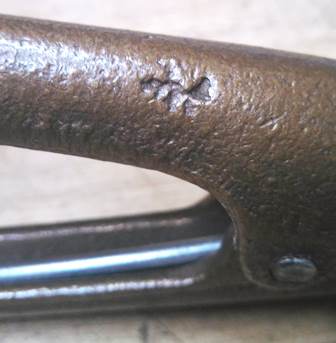
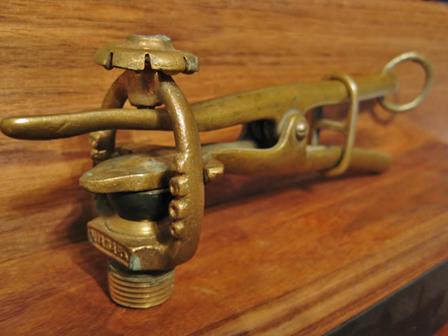
Here is the latest unknown tool. No maker's mark, but possibly a touch mark.
Received 11/30/2013
Hello, My great uncle has a whatsit collection
at his camp in Maine.
He dug many of the items
up behind his place back in the 1970's.
I was always fascinated by it and
may have attributed
to my hobby
of collecting old fire sprinkler items (plus, its what I do for a living).
I was searching the web for whatsits and the image of your brass implement
came up,
so I had to drop you a line. This item is a shut off tong for
open
sprinkler heads.
They were typically carried in fire trucks so when the
fire department arrived
to the scene of an alarm triggered by an open
fire sprinkler,
they could insert this clamp to stop the flow of water to reduce water
damage.
I would imagine old mills would have these on hand too in case
of emergencies,
or accidents.
As you can imagine, it was a wet affair.
I am sending a picture
of the set I have in my collection
with an old fused sprinkler head in
position.
Thanks! Kevin C.
Thank you, Kevin.
***********************************************************************************
Received 9/17/2013:
The item is called an alidade, used
by surveyors with a plane table for topographic mapping.
It is does not appear to be missing any parts. David
Thanks, David
This looks like a surveyor's instrument.
Only the two parts were in the leather case.
All are marked "U.S."
Any ideas on its intended use? Should there be any other parts here?
Walt
******************************************************************************
Received 9/15/2013:
On your Whats-It page, the item pictured at
top is a Weed Puller, patent number 1,065,606.
It was patented on June 24,
1913.
https://patentimages.storage.googleapis.com/pages/US1065606-0.png#
-Steve Thanks Steve.
